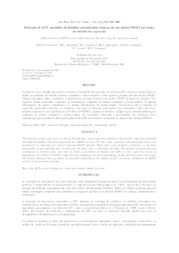Detecção de QTL, em dados de famílias estruturadas como as de um núcleo MOET por meio do método da regressão.
Detecção de QTL, em dados de famílias estruturadas como as de um núcleo MOET por meio do método da regressão.
Author(s): PEIXOTO, M. G. C. D.; MARTINEZ, M. L.; TEODORO, R. L.; MACHADO, M. A.; CARVALHO, M. R. S.; GOMES, F. C.; VERNEQUE, R. da S.
Summary: RESUMO - O objetivo deste trabalho foi avaliar a eficiência do método de regressão em detectar QTL com base na utilização de dados da estrutura de família (irmãos completos e meios-irmãos), como aqueles gerados em um núcleo MOET. Foram simulados dados fenotípicos e genotípicos em uma estrutura de núcleo MOET fechado de seleção. Três arquivos foram analisados, contendo: a) informações conjuntas de irmãos completos e meios-irmãos; b) apenas informações de irmãos completos e c) apenas informações de meios-irmãos. Verificou-se que o método da regressão, para dados discretos ou contínuos, foi capaz de detectar associações entre marcador e QTL em níveis bastante expressivos de significância (P<0.001 e P<0,0001), quando se utilizou o arquivo que continha informações conjuntas de irmãos completos e meios-irmãos. Os resultados indicaram a possibilidade de utilização dessa metodologia para estudos de detecção/validação de QTL em rebanhos ou núcleos de seleção que utilizam MOET. ABSTRACT - The objective of this study was to evaluate the efficiency of the regression method to detect QTL using data from full and half-sib families, like those generated in a MOET nucleus. For this study, genotypic and phenotypic data were simulated in a structure of a closed selection MOET nucleus. Three files were analyzed containing: a) the joint information of full and half sibs; b) only full sibs data; and c) only half sibs data. The method of regression, for continuous or discrete data, was able to detect associations of marker and QTL in very expressive levels of significance (P<0.001 P<0.0001), when the file containing the joint information of full and half sisters was used. The results indicated the possibility of using this methodology for studies of QTL detection / validation in MOET nucleus or herds under selection.
Publication year: 2009
Types of publication: Journal article
Unit: Embrapa Dairy Cattle
Keywords: Estrutura de família, Marcador Molecular, Poder de detecção
Observation
Some of Embrapa's publications are published as ePub files. To read them, use or download one of the following free software options to your computer or mobile device. Android: Google Play Books; IOS: iBooks; Windows and Linux: Calibre.
Access other publications
Access the Agricultural Research Database (BDPA) to consult Embrapa's full library collection and records.
Visit Embrapa Bookstore to purchase books and other publications sold by Embrapa.

